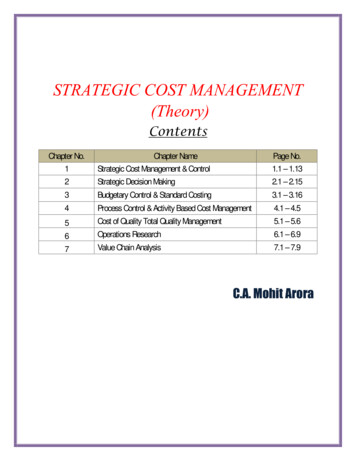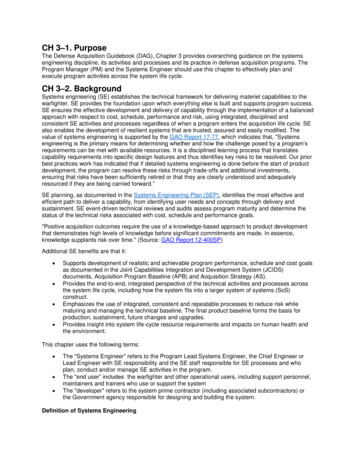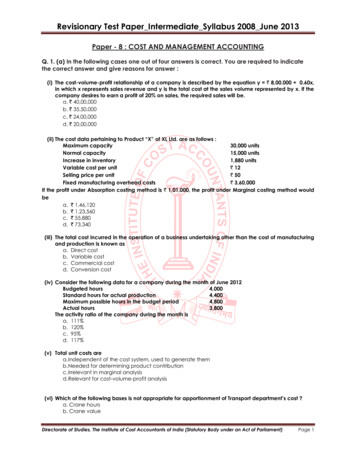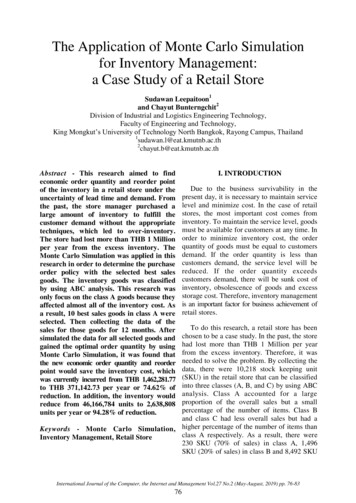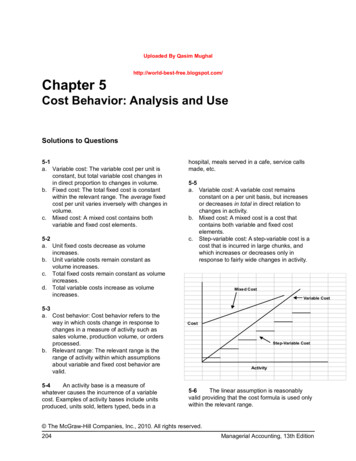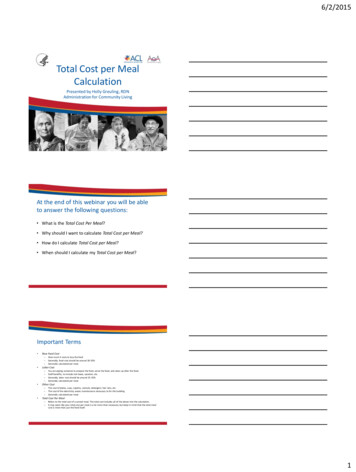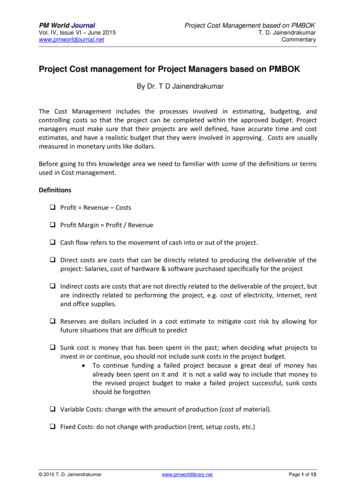
Transcription
PM World JournalProject Cost Management based on PMBOKVol. IV, Issue VI – June 2015www.pmworldjournal.netT. D. JainendrakumarCommentaryProject Cost management for Project Managers based on PMBOKBy Dr. T D JainendrakumarThe Cost Management includes the processes involved in estimating, budgeting, andcontrolling costs so that the project can be completed within the approved budget. Projectmanagers must make sure that their projects are well defined, have accurate time and costestimates, and have a realistic budget that they were involved in approving. Costs are usuallymeasured in monetary units like dollars.Before going to this knowledge area we need to familiar with some of the definitions or termsused in Cost management.Definitions Profit Revenue – Costs Profit Margin Profit / Revenue Cash flow refers to the movement of cash into or out of the project. Direct costs are costs that can be directly related to producing the deliverable of theproject: Salaries, cost of hardware & software purchased specifically for the project Indirect costs are costs that are not directly related to the deliverable of the project, butare indirectly related to performing the project, e.g. cost of electricity, Internet, rentand office supplies. Reserves are dollars included in a cost estimate to mitigate cost risk by allowing forfuture situations that are difficult to predict Sunk cost is money that has been spent in the past; when deciding what projects toinvest in or continue, you should not include sunk costs in the project budget. To continue funding a failed project because a great deal of money hasalready been spent on it and it is not a valid way to include that money tothe revised project budget to make a failed project successful, sunk costsshould be forgotten Variable Costs: change with the amount of production (cost of material). Fixed Costs: do not change with production (rent, setup costs, etc.) 2015 T. D. Jainendrakumarwww.pmworldlibrary.netPage 1 of 13
PM World JournalProject Cost Management based on PMBOKVol. IV, Issue VI – June 2015www.pmworldjournal.netT. D. JainendrakumarCommentary Net present value: the total present value (PV) of a time series of cash flows. It is astandard method for using the time value of money to appraise long-term projects.Higher the NPV is better. Discount rate: Minimum acceptable rate of return on an investment.Note that cash flow totals are equal, but NPVs are not because of the time value of money. (InProject 1 invested 5000 but 4th year it is crossing the break even with a margin of 1000. Inproject 2 in the 4th year it is crossing the breakeven point with higher margin that is 3000.Time value of money is more here, and NPV is higher). Internal Rate of Return: interest rate received for an investment consisting of paymentsand income that occur at regular periods (How fast the money come back to you afterthe investment). Technically speaking IRR is the discount rate when the present value of the cash inflowsequals the original investment. IRR is the discount rate when NPV equals zero You invest 100 and getting back 3 per annum every year, your IRR is 3%. But you invest 100 and you get back 60 first year and again 60 Next Year and stops,what is the IRR? You have to find the value of ‘r’ from the formula for finding NPV by equating with theRHS 0 (sum the discounted cost as negative number and discounted benefits aspositive numbers) 2015 T. D. Jainendrakumarwww.pmworldlibrary.netPage 2 of 13
PM World JournalProject Cost Management based on PMBOKVol. IV, Issue VI – June 2015www.pmworldjournal.netT. D. JainendrakumarCommentary -100(1 r)-0 60(1 r)-1 60(1 r)-2 0 here you have to find out the value of ‘r’ by trialand error method (trial at 0.14 value -1.2#0 Trial at 0.12 value 1.4#0 and trial at 0.13value 0.09 almost equal to 0 therefore IRR is 13%. Return on investment (ROI) is calculated by subtracting the project costs from thebenefits and then dividing by the costs. ROI (total discounted benefits - total discounted costs) / discounted costs (It is theincome divided by the investment) The higher the ROI, the better the project. Manyorganizations have a required rate of return or minimum acceptable rate of return oninvestment for project Opportunity Cost: The cost given up by selecting one project over another. Payback Period: The time it takes to recover your investment in the project before youstart accumulating profit.Earned Value Management EVM is a project performance measurement technique that integrates scope, time, &cost data Given a baseline, you can determine how well the project is meeting its goals You must enter actual information periodically to use EVM. Planned Value (PV), formerly called the budgeted cost of work scheduled (BCWS), alsocalled the budget, is that portion of the approved total cost estimate planned to bespent on an activity during a given period Actual Cost (AC), formerly called actual cost of work performed (ACWP), is the total ofdirect & indirect costs incurred in accomplishing work on an activity during a givenperiod Earned Value (EV), formerly called the budgeted cost of work performed (BCWP), is thepercentage of work actually completed multiplied by the actual cost. If the percentageof work is 100% then the earned value will be equal to planned value.Let us consider an example with the 5 work packages, PV & AC & % of work performed aregiven in the table below and each work packages has to be completed in a month’s time. Thismeans total duration of the project is 5 months and the values are given in dollars; let us dothe performance measurement and see how to find Earned value performance measurements. 2015 T. D. Jainendrakumarwww.pmworldlibrary.netPage 3 of 13
PM World JournalProject Cost Management based on PMBOKVol. IV, Issue VI – June 2015www.pmworldjournal.netT. D. JainendrakumarCommentaryWorkPlanned Valuepackage(PV)1.100000Actual Cost(AC)110000% of work Earnedperformed(WP) Value (EV)100%1000002.3.4.5.9000070000Not doneNot done80%50%1000001000001000001000007200035000(EV PV)ifWP is 100%EV AC*WP%-do In the above table Total Planned value (PV) for the work packages 1 to 3 that is in 3months is 300000 (add columns under PV up to work package 3) Similarly Total Actual Cost (AC) for the work packages 1 to 3 is 270000 Total Earned Value (EV) up to this stage is 207000 means that, in this project, tocomplete work package from 1 to 3, they have spent 270000 but the actual worth ofthe work completed is only 207000 that is earned value ( means over spend).Now let us find out the Performance measurements like Cost Variance (CV), Schedule Variance(SV), Cost Performance Index (CPI) and schedule performance index (SPI) Cost Variance (CV) EV – AC (207000 – 270000) -63000 (over spend) 63000 Schedule Variance(SV) EV – PV (207000-300000) -93000 means the work supposedto be planned to finish in 3 months in 300000 could not be achieved and actually spend270000 in 3 months, but actual worth (EV) of the work completed is 207000 means theremaining work worth of 93000 is lagging behind schedule. Cost Performance Index (CPI) EV/AC (207000/270000) 0.77 (Any value under 1.0shows bad that is over budget, if the value is 1.0 shows exactly as per plan( withinbudget) and if the value is above 1.0 shows under budget) Schedule Performance Index(SPI) EV/PV (207000/300000) 0.69 (Any value under 1.0shows bad that is behind the schedule, if the value is 1.0 shows it is on time and if thevalue is above 1.0 shows ahead of schedule)Next we are going to do the Forecasting from the above exampleForecastingEstimate at Completion EAC The management’s assessment of the cost of the project at completionAfter variance analysis, the estimated cost at completion is determinedCan use calculated indices or use management judgment. 2015 T. D. Jainendrakumarwww.pmworldlibrary.netPage 4 of 13
PM World JournalProject Cost Management based on PMBOKVol. IV, Issue VI – June 2015www.pmworldjournal.netT. D. JainendrakumarCommentary(Our BAC for the entire project 500000 (five months) and EV 207000, AC 270000,PV 300000, CPI 0.77, SPI 0.69If the Past performance is continuing means performance is continuing at the CPI of 0.771. EAC (BAC / CPI) 500,000 / 0.77 649350 means if the project is continuing as per thepast performance at the CPI of 0.77 then the project will be completed at the cost of649350Past performance will not continue in future (Initially some delay has occurred but in futureproject will be moving as per plan)1. EAC AC (BAC-EV) 270000 (500000-207000) 563000 Due to some problemsinitially some delay has occurred, but from the 4th month onwards project is assumedto be as per the plan that is the CPI 1 in that case we will take the Actual Cost up tothat stage, because past is past nothing can be done on that and add AC with theremaining work that is BAC-EV.2. Suppose at the third month you see that the estimation was entirely wrong in that caseEAC (AC Re-estimate (use bottom up estimation)), let us say the bottom up ETC is300000, then EAC 270000 300000 570000.3. In rare cases when SPI & CPI are having huge variation like CPI is 1 and SPI 0.60 to getthe more accurate EAC we have to consider the value of CPI and SPI in that case weuse the formula EAC (AC (BAC-EV/CPI*SPI)) in our case EAC 270000 (500000207000)/(0.77*0.60)) 821478, this is not realistic our CPI and SPI have no hugedifference, therefore this value of EAC is not applicable in this example and we have touse the assumption wisely.Estimate to CompletePast performance will not continue in future1. ETC BAC-EV (500000-207000) 293000, here estimate to complete is 293000(willcontinue as CPI 12. ETC Complete re-estimate and find out bottom-up ETC3. We can find ETC with EAC, take any of the above assumptions of EAC and subtractActual Cost that is ETC EAC-AC. ETC 649350-270000 379350 (assumption from thepast performance is continuing).Variance at CompletionVAC BAC-EAC (500000-649350) -149350 (EAC past performance will continue in future)This shows that the total variance by the time we complete the project will be 149350. 2015 T. D. Jainendrakumarwww.pmworldlibrary.netPage 5 of 13
PM World JournalProject Cost Management based on PMBOKVol. IV, Issue VI – June 2015www.pmworldjournal.netT. D. JainendrakumarCommentaryTo-Complete Performance IndexHow well do we have to perform to get back on trackThe calculated project of cost performance that must be achieved on the remaining work tomeet a specified goal (BAC or EAC).I. TCPI Work Remaining (BAC-EV)/Funds Remaining (BAC-AC)Assumption 1 (That is TCPI BAC-EV/BAC-AC (500000-207000)/(500000-270000) 1.27this means that if you continue the work at CPI 1.27 you will be able to finish the workwith in 500000.OrII. TCPI Work Remaining (BAC-EV)/Funds Remaining (EAC-AC)Assumption 2 (TCPI BAC-EV/EAC-AC (500000-270000)/( 649350-270000) 0.77 meansin this case if you continue the work with a CPI of 0.77 then you will be able to finish thework with a total cost of 649350.Plan Cost ManagementThis is the first process in the project cost management knowledge area which comes inplanning process group to establish the policies, procedures, & documentation for planning,managing, expending, and controlling project costs. It describes in detail how the project costswill be managed or how the rest of the process in this knowledge area will be carried out.Plan Cost Management: Inputs1. Project Management Plan, contains but not limited to: Scope Baseline Schedule Baseline Other Information (risks, communication, etc.)2. Project Charter (provides summary budget)3. Enterprise Environmental Factors (organizational culture, structure, market conditionsetc.)4. Organizational Process Assets(Financial control procedures, Historical Information’slessons learned, budgeting related policies, procedures and guidelines etc.)Plan Cost Management: T & T1. Expert Judgment (Expertise based on application area appropriate for the activities)2. Analytical Techniques (to understand the fund raising options)3. Meetings (Planning meeting with stakeholders) 2015 T. D. Jainendrakumarwww.pmworldlibrary.netPage 6 of 13
PM World JournalProject Cost Management based on PMBOKVol. IV, Issue VI – June 2015www.pmworldjournal.netT. D. JainendrakumarCommentaryPlan Cost Management: Output1. Cost Management Plan, can include but not limited to Units of Measure (centimeter, meter etc.) Level of Precision (rounded after two decimal points etc) Level of Accuracy ( or – 10%) or ( or – 30%) Control Accounts (Aggregated up to control of accounts level) Control Thresholds (How much CV & SV can vary) Rules for Performance Measurement Reporting Formats Process Description Additional DetailsEstimate CostsThis is the second Process in this knowledge area which comes in planning process group fordeveloping an approximation (estimate) for the cost of the resources necessary to completethe project activities. It is also important to develop a cost management plan that describeshow cost variances will be managed on the project and assessing pricing, how much theorganization will charge for the product or service.Estimate Costs: Inputs1. Cost Management Plan (output from the previous process)2. Human Resource Management Plan (project staffing details like personal rates etc.)3. Scope Baselines Scope Statement WBS WBS Dictionary4. Project Schedule (Planned start date, end date, duration etc.)5. Risk Register (to consider Risk mitigation costs)6. Enterprise Environmental Factors Market Conditions Published Commercial Data7. Organizational Process Assets Cost Estimating Policies Cost Estimating Templates Historical Information Lessons Learned 2015 T. D. Jainendrakumarwww.pmworldlibrary.netPage 7 of 13
PM World JournalProject Cost Management based on PMBOKVol. IV, Issue VI – June 2015www.pmworldjournal.netT. D. JainendrakumarCommentaryEstimate Costs: T & T1.2.3.4.Expert JudgmentAnalogous Estimating (Top down or Take Historical data for estimation))Parametric Estimating (Apply historical data with statistical data for estimation)Bottom-up estimating (Estimate from activity levels to WBS Level and to Control ofAccounts level and finally estimate the total cost of the project)5. Three-point Estimating (Triangular & Beta Distribution)a. Triangular Distribution Te (To Tm Tp)/3b. Beta Distribution (PERT) Te (To 4Tm Tp)/6(Where Te Total estimate, To Total optimistic, Tm Total most likely andTp Total Pessimistic)6. Reserve Analysis (Contingency reserve to manage known risk)7. Cost of Quality (Cost of appraisal or conformance & Cost of failure or nonconformance)8. Project Management Software (like primavera, MS-Project etc)9. Vendor Bid analysis (Vendor bid analysis to find out the cost of procurement of eachitems used for the project activities)10. Group Decision Making Techniques (brainstorming, Delphi, nominal groupTechnique)Estimate Costs: Output1. Activity Cost Estimates (Direct and Indirect cost required to complete the project)2. Basis of Estimates (supporting document includes : How it was developed Estimation Assumptions Constraints Range of possible estimates (e.g., -5% to 10 % in case of bottom up estimationor -25 % to 75% in case of Rough Order of Magnitude estimation or triangularestimation) Confidence Level of the estimate )3. Project Document Updates (Cost related documents and risk register)Determine BudgetThis is the third process in this knowledge area which comes under planning process group foraggregating the cost estimates of individual activities of work package to establish anauthorized cost baseline. 2015 T. D. Jainendrakumarwww.pmworldlibrary.netPage 8 of 13
PM World JournalProject Cost Management based on PMBOKVol. IV, Issue VI – June 2015www.pmworldjournal.netT. D. JainendrakumarCommentaryAn important goal of cost baseline is to have: A time-phased budget that project managers use to measure and monitor costperformanceEstimating costs for each major project activity over a time period providesmanagement with a foundation for project cost controlProviding information for project funding requirements –at what point(s) in time howmuch money will be neededDetermine Budget: Inputs1. Cost Management Plan (information regarding how the project cost will be managedand controlled)2. Scope Baseline (Scope statement, WBS and WBS dictionary)3. Activity Costs Estimates (Output from the previous process for aggregation up to workpackages)4. Basis of Estimates(Supporting details of the estimated cost)5. Project Schedule6. Resource Calendars (When a particular resource will be used in the project)7. Risk Register (How to aggregate risk response costs)8. Agreements (Cost related items in the agreements)9. Organizational Process Assets (cost estimating tools, formats, policies and proceduresetc.)Determine Budget: T & T1. Cost Aggregation (aggregating cost estimates to work package levels and further tocontrol of accounts level to find the cost base line)2. Reserve Analysis (Both contingency reserve and management reserve is created )3. Expert Judgment (Expert opinions from other units or stakeholders)4. Historical Relationships (To consider the analogous estimation or parametricestimation)5. Funding Limit Reconciliation (At a particular point of time how much fund is required ifthe project is running over budget or how much excess fund is available if the project isunder budget again if the project is going as per the plan, how much fund is required forcompleting the next phase etc., identified)Determine Budget: Outputs1. Cost Performance Baseline: Cost base line is the total project cost minus themanagement reserve for dealing the unknown risk. (Costs are aggregated activity levelincluding contingency to WBS level and again aggregate all the WBS level including thecontingency reserve will get the control of accounts and the sum of all the control ofaccounts will get the cost baseline, when we add management reserve for dealing withunknown risk to the aggregated control of accounts will give the total project cost. That 2015 T. D. Jainendrakumarwww.pmworldlibrary.netPage 9 of 13
PM World JournalProject Cost Management based on PMBOKVol. IV, Issue VI – June 2015www.pmworldjournal.netT. D. JainendrakumarCommentaryis if we minus management reserve from total project cost we will get the cost baseline.Cost base line is the time phased project budget excluding the management reserve.Cumulative cost values are given in the Y axis and if the project is progressing with timeas per the plan the funding requirements at the different point of time is shown in thegraph. If the project is not progressed as per the plan then the S curve will varyaccordingly and funding requirements also will vary. At a particular point of time howmuch fund is required if the project is running over budget or how much excess fund isavailable if the project is under budget again if the project is going as per the plan, howmuch fund is required for completing the next phase etc.,2. Project Funding Requirements (Management provide some amount by expecting thatthe project will run for a certain period and after reaching that again management willrelease the fund, but the project manager should ask the management for the requiredfund as per the performance measurement reports to carry out the project without anydelay.3. Project Document Updates : Performance reports, risk register, issue logs, milestone listetc.,Control CostsThis is the fourth process of this knowledge area which comes under monitoring and controlprocess group for monitoring the status of the project costs and managing the changes to thecost baseline, includes: Influencing the factors that create changes to the authorized baselineMonitoring cost performance to detect variances from the planEnsuring that all appropriate changes are recordedPreventing incorrect, inappropriate, or unauthorized changesInforming the appropriate stakeholders of authorized changesAnalyzing positive and negative variances and how it affects the other controlprocesses 2015 T. D. Jainendrakumarwww.pmworldlibrary.netPage 10 of 13
PM World JournalProject Cost Management based on PMBOKVol. IV, Issue VI – June 2015www.pmworldjournal.netT. D. JainendrakumarCommentaryControl Costs: Inputs1. Project Management Plan: Cost Baseline Cost Management Plan Project Funding Requirements2. Work Performance Indicators (activities that have been started and cost as per theschedule etc. has to be monitored)3. Organizational Process Assets (procedures for cost control etc.)Control Costs: T & T1.2.3.4.Earned Value Management (discussed)Forecasting (discussed)To-Complete Performance Index (discussed)Performance Reviews (are based on performance measurement and forecasting data) Variance Analysis Trend Analysis Earned Value Performance5. Reserve Analysis (status of the contingency and management reserve are monitored)6. Project Management Software (like primavera, MS-Project etc)Control Costs: Outputs1. Work Performance Measurements compared with planned and documented as workperformance information.2. Budget Forecasts3. Change Requests (Changes in the plan has to get approved from change control boardthrough perform integrated change control process)4. Project Management Plan Updates1. Cost Baseline2. Cost Management Plan5. Organizational Process Assets Updates (Causes of variance, organizational procedures,standards regarding cost monitoring and control)6. Project Document Updates (Cost estimates and basis of cost estimates are updated) 2015 T. D. Jainendrakumarwww.pmworldlibrary.netPage 11 of 13
PM World JournalProject Cost Management based on PMBOKVol. IV, Issue VI – June 2015www.pmworldjournal.netT. D. JainendrakumarCommentaryReferences:1. Guide to the Project Management Body of Knowledge (PMBOK ), 5th edition, ProjectManagement Institute, USA2. Information Technology Project Management, by Kathy Schwalbe PhD, PMP3. Project Management: A Systems Approach to Planning, Scheduling and Controlling, byHAROLD KERZNER, PH.D.4. https://www.google.co.in/search?q project funding s curve diagram%5C&es sm 93&biw 1280&bih 699&tbm isch&imgil B7foVxgM19UhOM%253A%253B L qw re.net%25252FNASAPMC%25252Fstephenbook&source iu&pf m&fir B7foVxgM19UhOM%253A%252C L qw NH6T0NBM%252C &usg Z s2E1IstO4GW05icRT0UZJ9bNc%3D&ved 0CC8Qyjc&ei 17u3VJiKLdKPuAS9mICABQ#imgdii &imgrc B395 2015 T. D. Jainendrakumarwww.pmworldlibrary.netPage 12 of 13
PM World JournalProject Cost Management based on PMBOKVol. IV, Issue VI – June 2015www.pmworldjournal.netT. D. JainendrakumarCommentaryAbout the AuthorDr. T D JainendrakumarDr. T D Jainendrakumar, PhD, MCA, PMP is an international PMPtrainer, EX-Scientist/Principal Scientist/Joint Director, N.I.C,Ministry of Information and Communication Technology, Government of India,Madhyapradesh. He has over 25 years’ of extensive experience in the areas of ITProject management in e-governance at Ernakulam District Collectorate, District Courtsof Kerala, Central Administrative Tribunal Ernakulam, Rajeev Gandhi National DrinkingWater Mission (400 crore project), New Delhi and Principal Systems Analyst in NationalInformatics Centre, Madhya Pradesh State Centre especially in the following areas ofspecialization: IT practice management (Project Management Methodologies, Toolsand techniques, Standards & Knowledge);IT Infrastructure Management (ProjectGovernance, Assessment, Organisational Instructions & Facilities and Equipments); ITResource Integration Management (Resource Management, Training & Education,Career Development & Team Development);IT-Technical Support (Project Mentoring,Project Planning, Project Auditing and Project Recovery); and Business AlignmentManagement (Project Portfolio management, Customer Relationship Management,Vendor Management & Business performance management).Teaching Project Management & ICT Subjects for professionals and post graduates.Master of Computer Applications (MCA), a 3 year post graduate course dealing withsoftware Engineering and Project Management from a premier institute Anna UniversityCampus. He is a PMP of PMI USA since 2008. Resource person of PMI, you can seehis name in the PMBOK 4th edition and 5th edition published by PMI, USA under thelist of contributors for project management. Scored 4.11 out of 5 in the projectmanagement (2005) examination conducted by brainbench.com, secured a MastersCertificate in Project Management, and is one among the top scorers (First in India and3rd position in the world in the experienced category).Published many international journal papers in PM World Today having cumulativeindex factors more than 2 in the areas of specialization of Project Management &Information Technology.Holding a Hon’ Doctorate from Cosmopolitan University, USA in Project Management &Information Technology. Presently working as an independent project managementconsultant and an International Project management (PMP) trainer. Provided PMPtraining to the senior officials of big MNCs like M/S. Earnest & Young and He is avisiting professor and sharing his knowledge and experience and to handle classes inManagement Information Systems, Quality Management, Project Management andSoftware Engineering to some of the big universities. He can be contacted atjainendrakumartd@ymail.com. 2015 T. D. Jainendrakumarwww.pmworldlibrary.netPage 13 of 13
Project Cost management for Project Managers based on PMBOK By Dr. T D Jainendrakumar The Cost Management includes the processes involved in estimating, budgeting, and controlling costs so that the project can be completed within the approved budget. Project managers must make sure that th




